Fine Japanese dining is easy to find in Taipei, but Shanhua Cuisine Japonaise (山花) stands a cut above the rest. The restaurant, which sports a facade that looks as if it was plucked straight out of an alleyway in Kyoto, offers simplicity and elegance with a warm, homey touch.
The same might be said of the Japanese-style multi-course meals, or kaiseki, served by restaurateur Lin Kun-tian (林昆田). The 50-year-old Kaohsiung native and life-long chef says he takes a strictly traditionalist approach in preparing meals.
Lin says the key to his meals are fresh ingredients, some locally sourced, most imported from Japan. He stays away from fancy sauces and sticks to simple garnishes, whether it’s a light soy sauce or freshly grated wasabi.
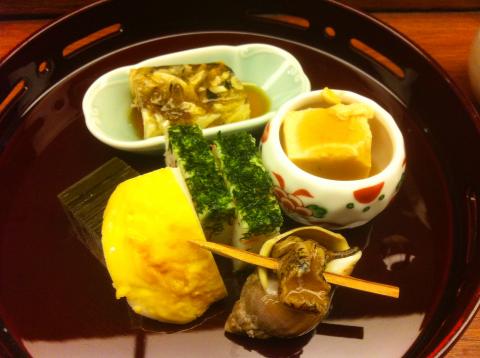
Photo by David Chen
A lunchtime visit left me impressed with Lin’s penchant for the basics. I went for the set of eight “mini-courses” (NT$1,000), which was full of subtle surprises and delights.
The meal started with a cube of sesame tofu topped with a glutinous soy sauce to whet the appetite, and then a platter of sashimi served on a bed of ice in a ceramic cup with a floral design. The petit cucumber with a flower growing out of the end was both a tasty and beautiful garnish.
The tuna and yellowtail slices were as fresh as could be and of high quality, but it was the raw shrimp that bowled me over. The coldness made it sing, and there was a buttery flavor that Lin says comes from a light squeeze of fresh lemon, a flavor I hadn’t noticed. In any case, shrimp will never be the same for me again, at least until my next visit.
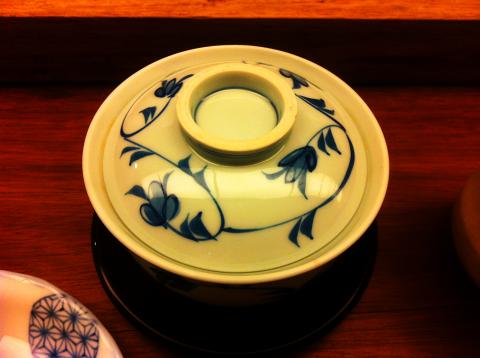
Photo by David Chen
The raw delights continued with a serving of calamari (also melt-in-your-mouth delicious), followed by a delicate cut of eel meat served in a light broth.
The next platter offered a bit of exotica: a slice of blowfish skin, which looked like and tasted a bit like jellied ham, and a tofu cube-sized block of monkfish liver, which I enjoyed for its savory, nutty flavor and buttery texture.
The main courses were grilled fish, which had firm but tender white meat similar to grouper, and a soul-satisfying bowl of steamed egg full of stringy mushrooms and chunks of yams. Just in case you aren’t full by this point, the “mini-course” meal ends with a bowl of rice with pickled vegetables and miso soup.
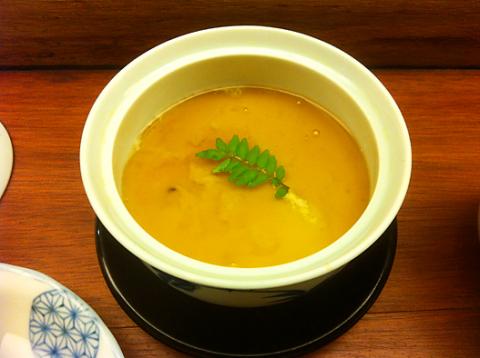
Photo by David Chen
The food and the interior are refined and minimalist, but the vibe is down-to-earth and welcoming. Billie Holliday played in the background as I sat at the solid wood bar in front of a stylish open-air kitchen, where Lin and his team of four chefs multi-tasked with ease. They sliced fish, grated wasabi root and manned the grill, all while engaging in friendly banter with customers, many of whom are middle-aged regulars and business-types.
There is no menu, as diners simply choose how much they want to pay: NT$1,000, NT$1,500 or NT$2,500 for lunch; NT$3,000, NT$4,000 or NT$5,000 for dinner. Higher prices get you more in quantity and quality of ingredients.
Shanhua, which is just a five-minute walk from Liuzhangli MRT Station (六張犁捷運站), is situated in the corner of an old concrete building in a nondescript neighborhood. The restaurant looks out of place with its clean, natural-hued exterior and sliding wooden doors, almost as if it were put there by mistake. Once inside, the food and the atmosphere will indeed transport you to another place.

Water management is one of the most powerful forces shaping modern Taiwan’s landscapes and politics. Many of Taiwan’s township and county boundaries are defined by watersheds. The current course of the mighty Jhuoshuei River (濁水溪) was largely established by Japanese embankment building during the 1918-1923 period. Taoyuan is dotted with ponds constructed by settlers from China during the Qing period. Countless local civic actions have been driven by opposition to water projects. Last week something like 2,600mm of rain fell on southern Taiwan in seven days, peaking at over 2,800mm in Duona (多納) in Kaohsiung’s Maolin District (茂林), according to

Aug. 11 to Aug. 17 Those who never heard of architect Hsiu Tse-lan (修澤蘭) must have seen her work — on the reverse of the NT$100 bill is the Yangmingshan Zhongshan Hall (陽明山中山樓). Then-president Chiang Kai-shek (蔣介石) reportedly hand-picked her for the job and gave her just 13 months to complete it in time for the centennial of Republic of China founder Sun Yat-sen’s birth on Nov. 12, 1966. Another landmark project is Garden City (花園新城) in New Taipei City’s Sindian District (新店) — Taiwan’s first mountainside planned community, which Hsiu initiated in 1968. She was involved in every stage, from selecting
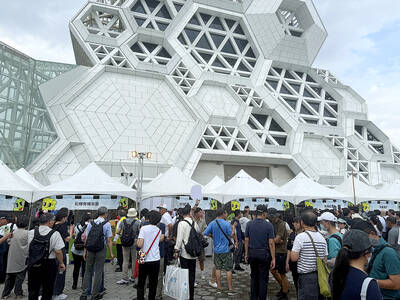
The latest edition of the Japan-Taiwan Fruit Festival took place in Kaohsiung on July 26 and 27. During the weekend, the dockside in front of the iconic Music Center was full of food stalls, and a stage welcomed performers. After the French-themed festival earlier in the summer, this is another example of Kaohsiung’s efforts to make the city more international. The event was originally initiated by the Japan-Taiwan Exchange Association in 2022. The goal was “to commemorate [the association’s] 50th anniversary and further strengthen the longstanding friendship between Japan and Taiwan,” says Kaohsiung Director-General of International Affairs Chang Yen-ching (張硯卿). “The first two editions
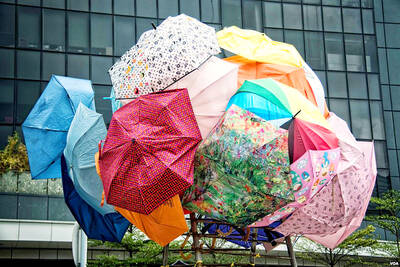
It was Christmas Eve 2024 and 19-year-old Chloe Cheung was lying in bed at home in Leeds when she found out the Chinese authorities had put a bounty on her head. As she scrolled through Instagram looking at festive songs, a stream of messages from old school friends started coming into her phone. Look at the news, they told her. Media outlets across east Asia were reporting that Cheung, who had just finished her A-levels, had been declared a threat to national security by officials in Hong Kong. There was an offer of HK$1m (NT$3.81 million) to anyone who could assist